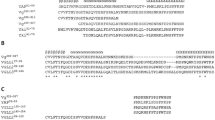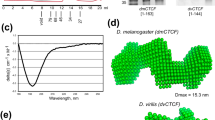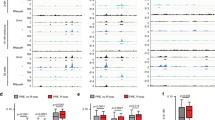Abstract
The human ALL-1 gene is involved in acute leukemia through gene fusions, partial tandem duplications or a specific deletion. Several sequence motifs within the ALL-1 protein, such as the SET domain, PHD fingers and the region with homology to DNA methyl transferase are shared with other proteins involved in transcription regulation through chromatin alterations. However, the function of these motifs is still not clear. Studying ALL-1 presents an additional challenge because the gene is the human homologue of Drosophila trithorax. The latter is a member of the trithorax-Polycomb gene family which acts to determine the body pattern of Drosophila by maintaining expression or repression of the Antennapedia-bithorax homeotic gene complex. Here we apply yeast two hybrid methodology, in vivo immunoprecipitation and in vitro `pull down' techniques to show self association of the SET motifs of ALL-1, TRITHORAX and ASH1 proteins (Drosophila ASH1 is encoded by a trithorax-group gene). Point mutations in evolutionary conserved residues of TRITHORAX SET, abolish the interaction. SET–SET interactions might act in integrating the activity of ALL-1 (TRX and ASH1) protein molecules, simultaneously positioned at different maintenance elements and directing expression of the same or different target genes.
This is a preview of subscription content, access via your institution
Access options
Subscribe to this journal
Receive 50 print issues and online access
$259.00 per year
only $5.18 per issue
Buy this article
- Purchase on Springer Link
- Instant access to full article PDF
Prices may be subject to local taxes which are calculated during checkout





Similar content being viewed by others
References
Cardoso C, Timsit S, Villard L, Khrestchatisky M, Fontes M and Colleaux L. . 1998 Hum. Mol. Genet. 7: 679–684.
Corda Y, Schramke V, Longhese MP, Smokvina T, Paciotti V, Brevet V, Gilson E and Géli V. . 1999 Nature Genet. 21: 204–208.
Cross SH, Meehan RR, Nan X and Bird A. . 1997 Nature Genet. 16: 256–259.
Cui X, De Vivo I, Slany R, Miyamoto A, Firestein R and Cleary ML. . 1998 Nature Genet. 18: 331–337.
Ekwall K, Nimmo ER, Javerzat JP, Borgstrom B, Egel R, Cranston G and Allshire R. . 1996 J. Cell Sci. 109: 2637–2648.
Gu Y, Nakamura T, Alder H, Prasad R, Canaani O, Cimino G, Croce CM and Canaani E. . 1992 Cell 71: 701–708.
Heim S and Mitelman F. . 1995 Cancer Cytogenetics. Wiley-Liss, NY:NY, USA.
Jenuwein T, Labile G, Dorn R and Reuter G. . 1998 Cell. Mol. Life Sci. 54: 80–93.
Jones RS and Gelbart WM. . 1993 Mol. Cell Biol. 13: 6357–6366.
Kuzin B, Tillib S, Sedkov Y, Mizrokhi L and Mazo A. . 1994 Gen. Dev. 8: 2478–2490.
Lewis EB. . 1978 Nature 276: 565–570.
Mazo A, Huang DH, Mozer BA and Dawid IB. . 1990 Proc. Natl. Acad. Sci. USA 87: 2112–2116.
Nislow C, Ray E and Pillus L. . 1997 Mol. Cell Biol. 8: 2421–2436.
Prasad R, Yano T, Sorio C, Nakamura T, Rallapalli R, Gu Y, Leshkowitz D, Croce CM and Canaani E. . 1995 Proc. Natl. Acad. Sci. USA 92: 12160–12164.
Prasad R, Zhadanov AB, Sedkov Y, Bullrich F, Druck T, Rallapalli R, Yano T, Alder H, Croce CM, Huebner K, Mazo A and Canaani E. . 1997 Oncogene 15: 549–560.
Raimondi SC. . 1993 Blood 81: 2237–2251.
Rasio D, Schichman SA, Negrini M, Canaani E and Croce CM. . 1996 Cancer Res. 56: 1766–1769.
Rozenblatt-Rosen O, Rozovskaia T, Burakov D, Sedkov Y, Tillib S, Blechman J, Croce C, Mazo A and Canaani E. . 1998 Proc. Natl. Acad. Sci. USA 95: 4152–4157.
Rozovskaia T, Tillib S, Smith S, Sedkov Y, Rozenblatt-Rozen O, Petruk S, Yano T, Nakamura T, Ben-Simchon L, Gildea Y, Croce CM, Shearn A, Canaani E and Mazo A. . 1999 Mol. Cell Biol. 19: 6441–6447.
Thanos D and Maniatis T. . 1995 Cell 89: 1091–1100.
Tkachuk DC, Kohler S and Cleary ML. . 1992 Cell 71: 691–700.
Tripoulas N, LaJeuness D, Gildea J and Shearn A. . 1996 Genetics 143: 913–928.
Tschiersch B, Hofmann A, Kraus V, Dorn R, Korge G and Reuter G. . 1994 EMBO J. 13: 3822–3831.
Yano T, Nakamura T, Blechman J, Sorio C, Dang CV, Geiger B and Canaani E. . 1997 Proc. Natl. Acad. Sci. USA, 94, 7286–7291.
Acknowledgements
This work was supported by grants from the German Institute of Cancer Research (DKFZ), The Israeli Academy of Science, The Louis and Fannie Tolz Fund, Israel Cancer Research Fund, The Israel Committee Against Cancer and by grant CA 50507 from the National Cancer Institute.
Author information
Authors and Affiliations
Rights and permissions
About this article
Cite this article
Rozovskaia, T., Rozenblatt-Rosen, O., Sedkov, Y. et al. Self-association of the SET domains of human ALL-1 and of Drosophila TRITHORAX and ASH1 proteins. Oncogene 19, 351–357 (2000). https://doi.org/10.1038/sj.onc.1203307
Received:
Revised:
Accepted:
Published:
Issue Date:
DOI: https://doi.org/10.1038/sj.onc.1203307
Keywords
This article is cited by
-
The Arabidopsis thaliana SET-domain-containing protein ASHH1/SDG26 interacts with itself and with distinct histone lysine methyltransferases
Journal of Plant Research (2012)
-
New insight into the molecular mechanisms of MLL-associated leukemia
Leukemia (2005)
-
Modulation of heat shock gene expression by the TAC1 chromatin-modifying complex
Nature Cell Biology (2004)
-
A dimeric viral SET domain methyltransferase specific to Lys27 of histone H3
Nature Structural & Molecular Biology (2003)
-
MLL5, a homolog of Drosophila trithorax located within a segment of chromosome band 7q22 implicated in myeloid leukemia
Oncogene (2002)



